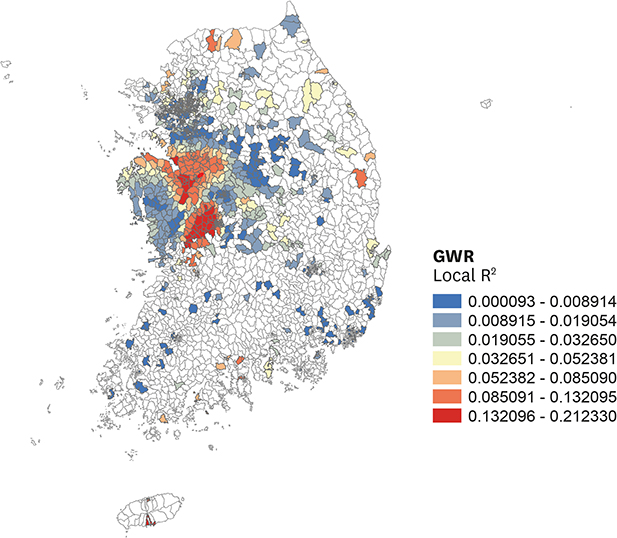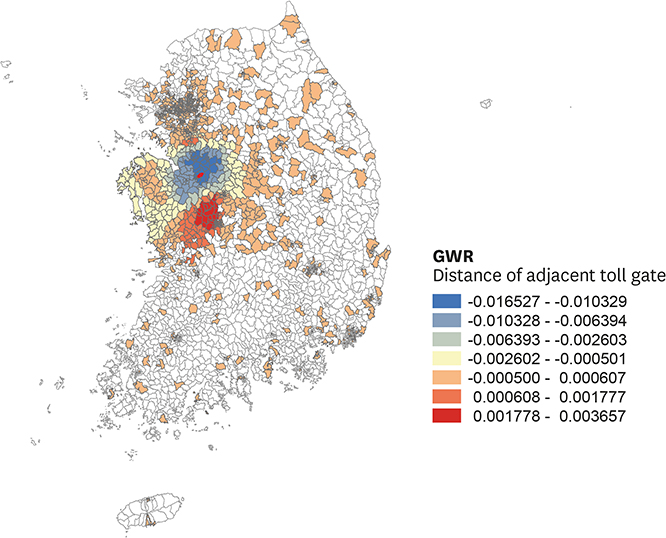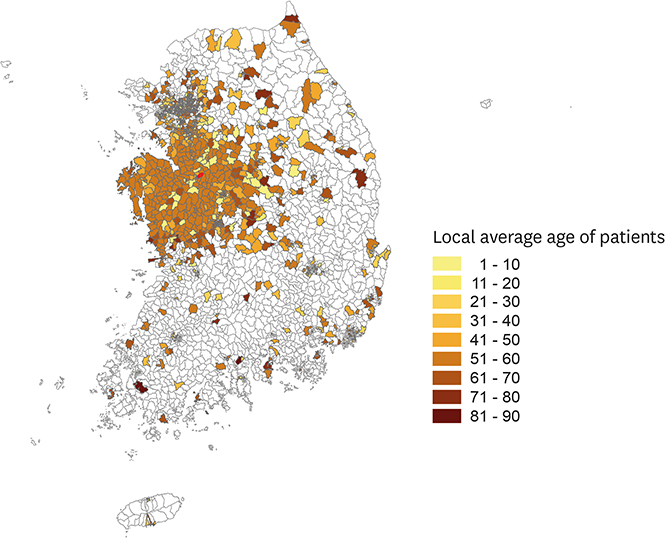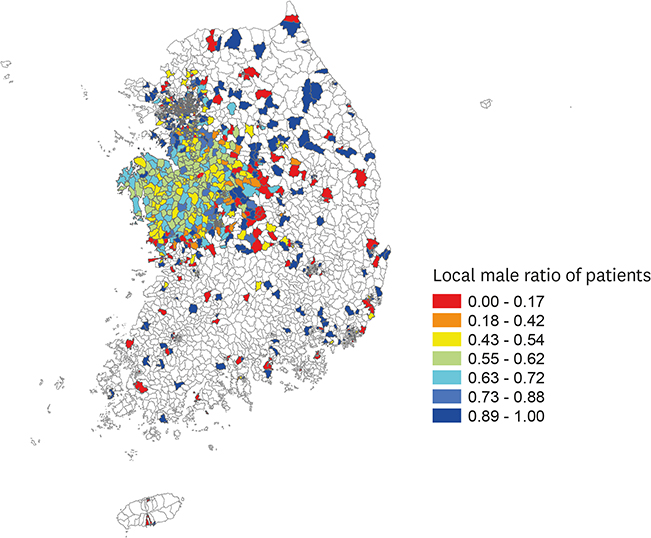J Periodontal Implant Sci.
2016 Jun;46(3):207-217. 10.5051/jpis.2016.46.3.207.
Geographic information system analysis on the distribution of patients visiting the periodontology department at a dental college hospital
- Affiliations
-
- 1Department of Dentistry, Dankook University College of Dentistry, Cheonan, Korea.
- 2Department of Urban Planning, Hanyang University Graduate School, Seoul, Korea.
- 3Department of Periodontology, Dankook University College of Dentistry, Cheonan, Korea. mia5683@dankook.ac.kr periopark@dankook.ac.kr
- 4Department of Urban Planning & Real Estate, Dankook University, Yongin, Korea. mia5683@dankook.ac.kr periopark@dankook.ac.kr
- 5Eastman Dental Institute, UCL, London, UK.
- KMID: 2382984
- DOI: http://doi.org/10.5051/jpis.2016.46.3.207
Abstract
- PURPOSE
The aim of this study is to analyze and visualize the distribution of patients visiting the periodontology department at a dental college hospital, using a geographic information system (GIS) to utilize these data in patient care and treatment planning, which may help to assess the risk and prevent periodontal diseases.
METHODS
Basic patient information data were obtained from Dankook University Dental Hospital, including the unit number, gender, date of birth, and address, down to the dong (neighborhood) administrative district unit, of 306,656 patients who visited the hospital between 2007 and 2014. The data of only 26,457 patients who visited the periodontology department were included in this analysis. The patient distribution was visualized using GIS. Statistical analyses including multiple regression, logistic regression, and geographically weighted regression were performed using SAS 9.3 and ArcGIS 10.1. Five factors, namely proximity, accessibility, age, gender, and socioeconomic status, were investigated as the explanatory variables of the patient distribution.
RESULTS
The visualized patient data showed a nationwide scale of the patient distribution. The mean distance from each patient's regional center to the hospital was 30.94±29.62 km and was inversely proportional to the number of patients from the respective regions. The distance from a regional center to the adjacent toll gate had various effects depending on the local distance from the hospital. The average age of the patients was 52.41±12.97 years. Further, a majority of regions showed a male dominance. Personal income had inconsistent results between analyses.
CONCLUSIONS
The distribution of patients is significantly affected by the proximity, accessibility, age, gender and socioeconomic status of patients, and the patients visiting the periodontology department travelled farther distances than those visiting the other departments. The underlying reason for this needs to be analyzed further.
MeSH Terms
Figure
Reference
-
1. Horner MW, Mascarenhas AK. Analyzing location-based accessibility to dental services: an Ohio case study. J Public Health Dent. 2007; 67:113–118.
Article2. Caprarelli G, Fletcher S. A brief review of spatial analysis concepts and tools used for mapping, containment and risk modelling of infectious diseases and other illnesses. Parasitology. 2014; 141:581–601.
Article3. Naves LA, Porto LB, Rosa JW, Casulari LA, Rosa JW. Geographical information system (GIS) as a new tool to evaluate epidemiology based on spatial analysis and clinical outcomes in acromegaly. Pituitary. 2015; 18:8–15.
Article4. Sun W, Gong J, Zhou J, Zhao Y, Tan J, Ibrahim AN, et al. A spatial, social and environmental study of tuberculosis in China using statistical and GIS technology. Int J Environ Res Public Health. 2015; 12:1425–1448.
Article5. McGuire S, Kruger E, Tennant M. Travel patterns for government emergency dental care in Australia: a new approach using GIS tools. Aust Dent J. 2011; 56:389–393.
Article6. Goli A, Oroei M, Jalalpour M, Faramarzi H, Askarian M. The spatial distribution of cancer incidence in fars province: a GIS-based analysis of cancer registry data. Int J Prev Med. 2013; 4:1122–1130.7. Genco RJ, Borgnakke WS. Risk factors for periodontal disease. Periodontol 2000. 2013; 62:59–94.
Article8. Kim DW, Park JC, Rim TT, Jung UW, Kim CS, Donos N, et al. Socioeconomic disparities of periodontitis in Koreans based on the KNHANES IV. Oral Dis. 2014; 20:551–559.
Article9. Genco RJ. Current view of risk factors for periodontal diseases. J Periodontol. 1996; 67:Suppl. 1041–1049.
Article10. Pereira SM, Ambrosano GM, Cortellazzi KL, Tagliaferro EP, Vettorazzi CA, Ferraz SF, et al. Geographic information systems (GIS) in assessing dental health. Int J Environ Res Public Health. 2010; 7:2423–2436.
Article11. Kruger E, Whyman R, Tennant M. High-acuity GIS mapping of private practice dental services in New Zealand: does service match need? Int Dent J. 2012; 62:95–99.
Article12. Kurcz R, Kruger E, Tennant M. Using GIS to analyse dental practice distribution in Indiana, USA. Community Dent Health. 2013; 30:155–160.13. Tennant M, Kruger E, Shiyha J. Dentist-to-population and practice-to-population ratios: in a shortage environment with gross mal-distribution what should rural and remote communities focus their attention on? Rural Remote Health. 2013; 13:2518.
Article14. Derbi HA, Kruger E, Tennant M. Incidence of oral cancer in Western Australia (1982-2009): Trends and regional variations. Asia Pac J Clin Oncol. 2016; 12:e305–10.
Article15. Joo HT, Jeong BJ, Cho IW, Shin HS, Lim MH, Park JC. Geographic information system (GIS) analysis on the distribution of patients visiting at a dental college hospital: a pilot study. J Dent Rehabil Appl Sci. 2015; 31:283–293.
Article16. Park IS. An analysis on metropolitan concentration factors of health care utilization in local cancer patients using GWR. J Community Welf. 2016; 56:29–56.
Article17. Jo DG. GIS and geographically weighted regression in the survey research of small areas. Surv Res. 2009; 10:1–19.18. Eke PI, Dye BA, Wei L, Slade GD, Thornton-Evans GO, Borgnakke WS, et al. Update on prevalence of periodontitis in adults in the United States: NHANES 2009 to 2012. J Periodontol. 2015; 86:611–622.
Article19. Krishnatreya M, Saikia A, Kataki A, Sharma J, Baruah M. Variations in the spatial distribution of gall bladder cancer: a call for collaborative action. Ann Med Health Sci Res. 2014; 4:Suppl 3. S329–31.
Article20. Walker BB, Schuurman N, Hameed SM. A GIS-based spatiotemporal analysis of violent trauma hotspots in Vancouver, Canada: identification, contextualisation and intervention. BMJ Open. 2014; 4:e003642.
Article21. Tennant M, Kruger E. Turning Australia into a ‘flat-land’: what are the implications for workforce supply of addressing the disparity in rural-city dentist distribution? Int Dent J. 2014; 64:29–33.
Article22. Han DH, Lee HJ, Lim S. Smoking induced heavy metals and periodontitis: findings from the Korea National Health and Nutrition Examination Surveys 2008-2010. J Clin Periodontol. 2013; 40:850–858.
Article23. Labriola A, Needleman I, Moles DR. Systematic review of the effect of smoking on nonsurgical periodontal therapy. Periodontol 2000. 2005; 37:124–137.
Article24. Wan CP, Leung WK, Wong MC, Wong RM, Wan P, Lo EC, et al. Effects of smoking on healing response to non-surgical periodontal therapy: a multilevel modelling analysis. J Clin Periodontol. 2009; 36:229–239.
Article
- Full Text Links
- Actions
-
Cited
- CITED
-
- Close
- Share
- Similar articles
-
- Geographic information system (GIS) analysis on the distribution of patients visiting at a dental college hospital: a pilot study
- Assessing Spatial Accessibility to Pediatric Dental Clinics Using the Geographic Information System
- Trends in Malocclusion Patients of Yeungnam University Hospital
- The Distribution of Pediatric Patients According to Accessibility to Dental Facilities in Pusan National University Dental Hospital
- Empirical Analysis of Geographic Inequalities in the Distribution of Nurses





